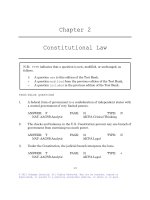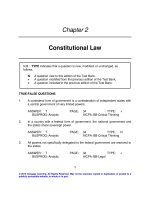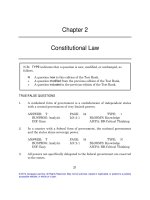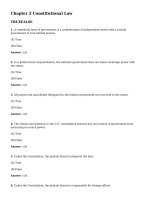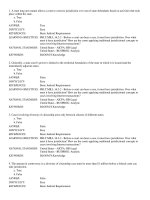Bus law today 9th ed ch18
Bạn đang xem bản rút gọn của tài liệu. Xem và tải ngay bản đầy đủ của tài liệu tại đây (359.96 KB, 43 trang )
BUSINESS LAW TODAY
Essentials 9th Ed.
Roger LeRoy Miller - Institute for University Studies, Arlington, Texas
Gaylord A. Jentz - University of Texas at Austin, Emeritus
Chapter
18
Employment Law
© 2011 Cengage Learning. All Rights Reserved. May not be copied, scanned, or duplicated, in whole or in part, except for use as permitted in
a license distributed with a certain product or service or otherwise on a password-protected website for classroom use.
1
Learning Objectives
What is the employment-at-will doctrine?
When and why are exceptions to this
doctrine made?
What federal statute governs working
hours and wages?
Under the Family and Medical Leave Act of
1993, under what circumstances may an
employee take family or medical leave?
© 2011 Cengage Learning. All Rights Reserved. May not be copied, scanned, or duplicated, in whole or in part, except for use as permitted in
a license distributed with a certain product or service or otherwise on a password-protected website for classroom use.
2
Learning Objectives
What are the two most important federal
statutes governing immigration and
employment today?
Generally, what kind of conduct is
prohibited by the Title VII Civil Rights Act,
as amended?
© 2011 Cengage Learning. All Rights Reserved. May not be copied, scanned, or duplicated, in whole or in part, except for use as permitted in
a license distributed with a certain product or service or otherwise on a password-protected website for classroom use.
3
Employment-at-Will
Historically, employment law was governed
by the common law doctrine of
“employment at will” where either employer
or employee could terminate the
relationship at any time, for any reason.
Today employment law is heavily regulated
by state and federal statutes.
© 2011 Cengage Learning. All Rights Reserved. May not be copied, scanned, or duplicated, in whole or in part, except for use as permitted in
a license distributed with a certain product or service or otherwise on a password-protected website for classroom use.
4
Employment-at-Will
The doctrine of employment-at-will allows
the employer and the employee to
terminate employment at any time, for any
reason, without liability.
Some states recognize one or more
judicial exceptions to this rule, while
some states recognize none.
© 2011 Cengage Learning. All Rights Reserved. May not be copied, scanned, or duplicated, in whole or in part, except for use as permitted in
a license distributed with a certain product or service or otherwise on a password-protected website for classroom use.
5
Exceptions to At-Will
Contract Exceptions:
An implied contract
exists between employer and employee.
Oral agreements may become part of the
implied contract.
Tort Exceptions: Wrongful discharge,
defamation may be actionable.
Public Policy Exceptions (Whistleblowing).
Wrongful Discharge.
© 2011 Cengage Learning. All Rights Reserved. May not be copied, scanned, or duplicated, in whole or in part, except for use as permitted in
a license distributed with a certain product or service or otherwise on a password-protected website for classroom use.
6
Wage and Hour Laws
Child Labor.
Fair Labor Standards
Act (1938) prohibits
oppressive child labor
practices. Provides
regulations for work,
depending on the age of
child.
© 2011 Cengage Learning. All Rights Reserved. May not be copied, scanned, or duplicated, in whole or in part, except for use as permitted in
a license distributed with a certain product or service or otherwise on a password-protected website for classroom use.
7
Wage and Hour Laws
Wages and Hours.
Davis-Bacon Act -- the prevailing wage act.
Walsh-Healey Act -- the beginning of minimum
wages.
Fair Labor Standards Act (FLSA) -- an
extension of wage and hour regulation to
workers in interstate commerce.
Overtime Exemptions.
Certain employees (usually executive,
administrative, and professional) are exempt
from overtime.
© 2011 Cengage Learning. All Rights Reserved. May not be copied, scanned, or duplicated, in whole or in part, except for use as permitted in
a license distributed with a certain product or service or otherwise on a password-protected website for classroom use.
8
Layoffs
Worker Adjustment and Retraining
Notification Act.
Intended to give employees advance notice in
the event of a “mass layoff.”
Mass layoff: during 30 day period, loss of at
least 33% full-time and 50 employees, OR
Loss of 500 hundred employees.
Remedies for Violations: $500/day, plus back
pay, medical benefits.
© 2011 Cengage Learning. All Rights Reserved. May not be copied, scanned, or duplicated, in whole or in part, except for use as permitted in
a license distributed with a certain product or service or otherwise on a password-protected website for classroom use.
9
Family Medical Leave Act
The FMLA requires employers with over
50 employees to provide unpaid leave to
employees who need to care for a spouse,
child, or parent suffering with a serious
medical condition.
The employee cannot be terminated for
taking leave under the policy, and has the
right to restoration to the same or a
similar position upon return to work.
© 2011 Cengage Learning. All Rights Reserved. May not be copied, scanned, or duplicated, in whole or in part, except for use as permitted in
a license distributed with a certain product or service or otherwise on a password-protected website for classroom use.
10
The Occupational Safety and
Health Act (OSHA)
The fundamental federal law aimed toward
safety in the workplace.
Enforcement is by OSHA, NIOSH, and the
OSHRC.
Procedures and Violations: Employers with
11 or more employees required to keep
records.
© 2011 Cengage Learning. All Rights Reserved. May not be copied, scanned, or duplicated, in whole or in part, except for use as permitted in
a license distributed with a certain product or service or otherwise on a password-protected website for classroom use.
11
State Worker’s Compensation
Laws
These laws reduce employer liability to
employees for workplace injuries, and
provide a measure of assurance that
workplace injuries will be compensated,
regardless of the solvency of the employer,
by:
Requiring that injured employees make a
claim against the employer’s workers’
compensation insurance policy, instead of
suing the employer.
Requiring most employers to carry workers’
compensation insurance.
© 2011 Cengage Learning. All Rights Reserved. May not be copied, scanned, or duplicated, in whole or in part, except for use as permitted in
a license distributed with a certain product or service or otherwise on a password-protected website for classroom use.
12
Income Security
Social Security and Welfare.
Medicare.
Federally funded health insurance for people
aged 65 or older.
Private Pension Plans.
Employee Retirement Income Security Act
(ERISA) gives employee a vested right to receive
pension benefits at a future date when she stops
working.
Unemployment Insurance.
© 2011 Cengage Learning. All Rights Reserved. May not be copied, scanned, or duplicated, in whole or in part, except for use as permitted in
a license distributed with a certain product or service or otherwise on a password-protected website for classroom use.
13
COBRA
COBRA prohibits the discontinuance of
insurance benefits of workers who have
voluntarily or involuntarily been separated
from work, unless the involuntary
separation was on the basis of gross
misconduct.
Employers must comply if they have more
than 20 employees.
© 2011 Cengage Learning. All Rights Reserved. May not be copied, scanned, or duplicated, in whole or in part, except for use as permitted in
a license distributed with a certain product or service or otherwise on a password-protected website for classroom use.
14
Employer-Sponsored
Group Health Plans
Health Insurance Portability and
Accountability Act (HIPAA)
Does not require health coverage but does
establish requirements for those that do.
© 2011 Cengage Learning. All Rights Reserved. May not be copied, scanned, or duplicated, in whole or in part, except for use as permitted in
a license distributed with a certain product or service or otherwise on a password-protected website for classroom use.
15
Employee Privacy Rights
Electronic Monitoring in the Workplace.
Employee Privacy Under Constitutional and
Tort Law. Personal right to privacy may not
apply to work computers, especially if there is a
policy manual.
Electronic Communications Privacy Act.
Stored Communications (part of ECPA).
© 2011 Cengage Learning. All Rights Reserved. May not be copied, scanned, or duplicated, in whole or in part, except for use as permitted in
a license distributed with a certain product or service or otherwise on a password-protected website for classroom use.
16
Employee Privacy Rights
Other Types of Monitoring.
Lie Detectors.
Drug and Genetic Testing.
What about preemployment screening
procedures?
© 2011 Cengage Learning. All Rights Reserved. May not be copied, scanned, or duplicated, in whole or in part, except for use as permitted in
a license distributed with a certain product or service or otherwise on a password-protected website for classroom use.
17
Immigration Law
Immigration Reform and Control Act of
1986.
Amnesty to certain groups of illegal aliens living
in the United States.
Sanctions for employers.
Criminal and Civil Penalties.
Antidiscrimination Provisions.
© 2011 Cengage Learning. All Rights Reserved. May not be copied, scanned, or duplicated, in whole or in part, except for use as permitted in
a license distributed with a certain product or service or otherwise on a password-protected website for classroom use.
18
Immigration Law
Immigration Act of 1990.
I-9 Employment Verification by Employers.
I-551 Alien Registration Receipts.
H-1 B Visa Program.
Labor Certification.
H-2, O, L, and E Visas.
CASE 18.1
Castellanos-Contreras v. Decatur
Hotels, LLC. (2009). Guest workers are liable for
their own recruitment, transportation, and visa
expenses if incurred without employer’s
knowledge.
© 2011 Cengage Learning. All Rights Reserved. May not be copied, scanned, or duplicated, in whole or in part, except for use as permitted in
a license distributed with a certain product or service or otherwise on a password-protected website for classroom use.
19
Title VII of the Civil Rights Act
of 1964
Title VII prohibits discrimination in
employment on the basis of race, sex,
color, religion, and national origin. “Sex”
now includes pregnancy.
In addition to prohibiting religious
discrimination, employers must
reasonably accommodate an employee’s
religious practices.
Enforcement of Title VII by EEOC.
© 2011 Cengage Learning. All Rights Reserved. May not be copied, scanned, or duplicated, in whole or in part, except for use as permitted in
a license distributed with a certain product or service or otherwise on a password-protected website for classroom use.
20
Intentional vs. Unintentional
Discrimination
Intentional (“Disparate-Treatment”)
Discrimination. For prima facie case,
applicant must prove:
She is member of a protected class;
Applied, qualified and rejected for job; and
Employer continued to seek applicants.
Unintentional (“Disparate Impact”)
Discrimination.
No-protected applicant sues Employer who
tries to integrate members of protected
classes into workplace.
© 2011 Cengage Learning. All Rights Reserved. May not be copied, scanned, or duplicated, in whole or in part, except for use as permitted in
a license distributed with a certain product or service or otherwise on a password-protected website for classroom use.
21
Discrimination Based on Race,
Color, and National Origin
Title VII prohibits employment policies or
intentional/ negligent discrimination on basis
of race, color or national origin.
Company policies that discriminate are illegal,
unless (except for race) they have a
substantial demonstrable relationship to
realistic qualifications for job.
Reverse Discrimination: discrimination
against “majority” such as white males.
See Richi v. Destefano (2009) involving white New
Haven firefighters who were discriminated against by
fire department be throwing out a promotion test.
© 2011 Cengage Learning. All Rights Reserved. May not be copied, scanned, or duplicated, in whole or in part, except for use as permitted in
a license distributed with a certain product or service or otherwise on a password-protected website for classroom use.
22
Discrimination Based on
Religion
Accommodation:
Employers must
“reasonably accommodate” the “sincerely
held’ religious practices of its employees,
unless to do so would cause undue
hardship to employer’s business.
© 2011 Cengage Learning. All Rights Reserved. May not be copied, scanned, or duplicated, in whole or in part, except for use as permitted in
a license distributed with a certain product or service or otherwise on a password-protected website for classroom use.
23
Discrimination Based on
Gender
Title VII prohibits employers from classifying
jobs as male or female or from advertising
such, unless employer can prove gender is
essential to the job.
Plaintiff must show gender was determining
factor in hiring, firing or lack of promotion.
2009 “Lilly Ledbetter Fair Pay Act” Equal Pay
Legislation: removed time limits to file suit.
Constructive Discharge.
Voluntarily leaves because conditions “intolerable.”
Applies to all Title VII discrimination.
© 2011 Cengage Learning. All Rights Reserved. May not be copied, scanned, or duplicated, in whole or in part, except for use as permitted in
a license distributed with a certain product or service or otherwise on a password-protected website for classroom use.
24
Sexual Harassment
U.S. Supreme Court has interpreted Title
VII’s prohibition against sex
discrimination to include a prohibition
against sexual harassment.
There are currently two forms of
recognized sexual harassment:
Hostile Work Environment.
Quid Pro Quo.
© 2011 Cengage Learning. All Rights Reserved. May not be copied, scanned, or duplicated, in whole or in part, except for use as permitted in
a license distributed with a certain product or service or otherwise on a password-protected website for classroom use.
25



